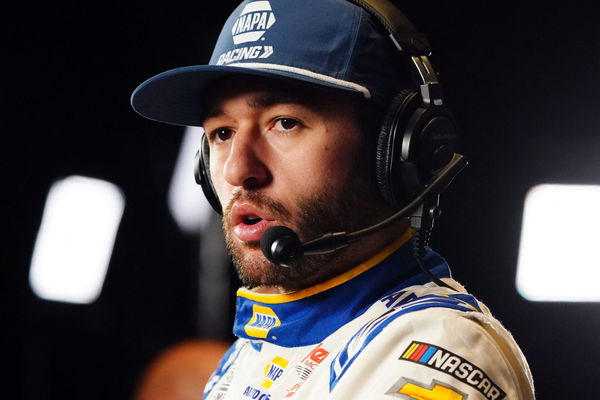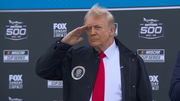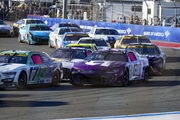
USA Today via Reuters
Feb 14, 2024; Daytona Beach, Florida, USA; NASCAR Cup Series driver Chase Elliott (9) speaks with reporters during media day at Daytona International Speedway. Mandatory Credit: John David Mercer-USA TODAY Sports

USA Today via Reuters
Feb 14, 2024; Daytona Beach, Florida, USA; NASCAR Cup Series driver Chase Elliott (9) speaks with reporters during media day at Daytona International Speedway. Mandatory Credit: John David Mercer-USA TODAY Sports
With our eyes etched on the Chicago race, there is no denying that the Nashville fever has not gone down among fans and drivers alike. Last weekend’s Cup race made history as the longest overtime race to have unfolded. The rain-washed track transformed into a slippery chaos, bringing out caution after caution, thus stretching the initial 300 laps by 31 more.
This hullabaloo meant diverse fates for drivers, as some crashed out while others stuck around till the end. Chase Elliott ranked in the sad lot as the No. 9 Chevrolet got himself into trouble. The Hendrick Motorsports driver was also not pleased with NASCAR, allowing the chaotic race to continue.
ADVERTISEMENT
Article continues below this ad
Chase Elliott holds NASCAR’s rule under scrutiny
The Ally 400 race defied all expectations, featuring five overtimes. The drama began with a collision between Austin Cindric and Noah Gragson, thus triggering a series of wild reshuffles that saw heavyweight racers like Denny Hamlin and Kyle Larson running out of gas and faltering. Eventually, Joey Logano persisted till the end, and Craftsman Truck champion Zane Smith secured his career-best runner-up finish.
But Chase Elliott, who got involved in a wreck before the overtime fest, criticized the interminably long race.
Talking to Frontstretch after the race, Elliott flatly denied that the overtime rule is okay as it is. “No. If I was a fan and I watched a race and under caution,” Elliott began, proceeding to drop a four-word truth bomb, “I would be pissed.” And it is pretty understandable from his lens as Elliott got loose and spun out on lap 218, way before the overtime period began.
What’s your perspective on:
Chase Elliott's grit at Nashville—Is he the toughest driver in NASCAR right now?
Have an interesting take?
But what rule is Chase Elliott exactly talking about? Introduced in 2017, the unlimited “green-white-checkered finishes” rule is pretty simple. After the caution flag is waved, the drivers should race cleanly for another two laps. The onus is on the leader to cross the line to receive the white flag and then the next flag ends the race. But this leaves room for tediously long chaotic races like Nashville, and several fans and Chase Elliott criticized this.
The overtime also led to unpredictable twists as the leaderboard shuffled wildly. For instance, Kyle Busch fueled fans’ excitement as he came close to a strong finish until an unfortunate series of events led him to wreck out.
Then an unlikely face emerged as the podium holder beside Joey Logano – Zane Smith. It is natural that such jumbled storylines boggle people.
ADVERTISEMENT
Article continues below this ad
Having said that, NASCAR’s current overtime rule has a positive side. It ranks way better than past rules, which produced some chilling incidents.
Trending
The unlimited ‘green white checkered’ rule is the lesser evil
Although Chase Elliott is critical of the unlimited GWC rule, history books tell us we are in a better era now. Earlier, NASCAR simply ended a race when an overtime caution flag waved. Dale Earnhardt Sr won the 1998 Daytona 500 similarly, under caution, leading to an anticlimactic finish to the race. In 2004, a one GWC flag rule was introduced – but it led to controversies like Jeff Gordon’s humiliation in the 2007 Talladega race.
ADVERTISEMENT
Article continues below this ad
Then a three GWC flag rule came under fire as well, creating too much carnage on superspeedways. Under the resumed one GWC rule, Kevin Harvick wreaked havoc in 2015. He seemed to intentionally crash Trevor Bayne in order to hang onto a playoff spot before his dying engine cost him too many points. So eventually NASCAR settled with the unlimited green-white-checkered flag rule in 2017.
Hence, Chase Elliott and some fans’ verdict may be true in the entertainment sense. However, the current rule makes for the least on-track conflict and carnage. Do you think if the current rule wasn’t in place, then the Nashville race would have been more chaotic than it already was?
ADVERTISEMENT
ADVERTISEMENT
ADVERTISEMENT
ADVERTISEMENT







Chase Elliott's grit at Nashville—Is he the toughest driver in NASCAR right now?